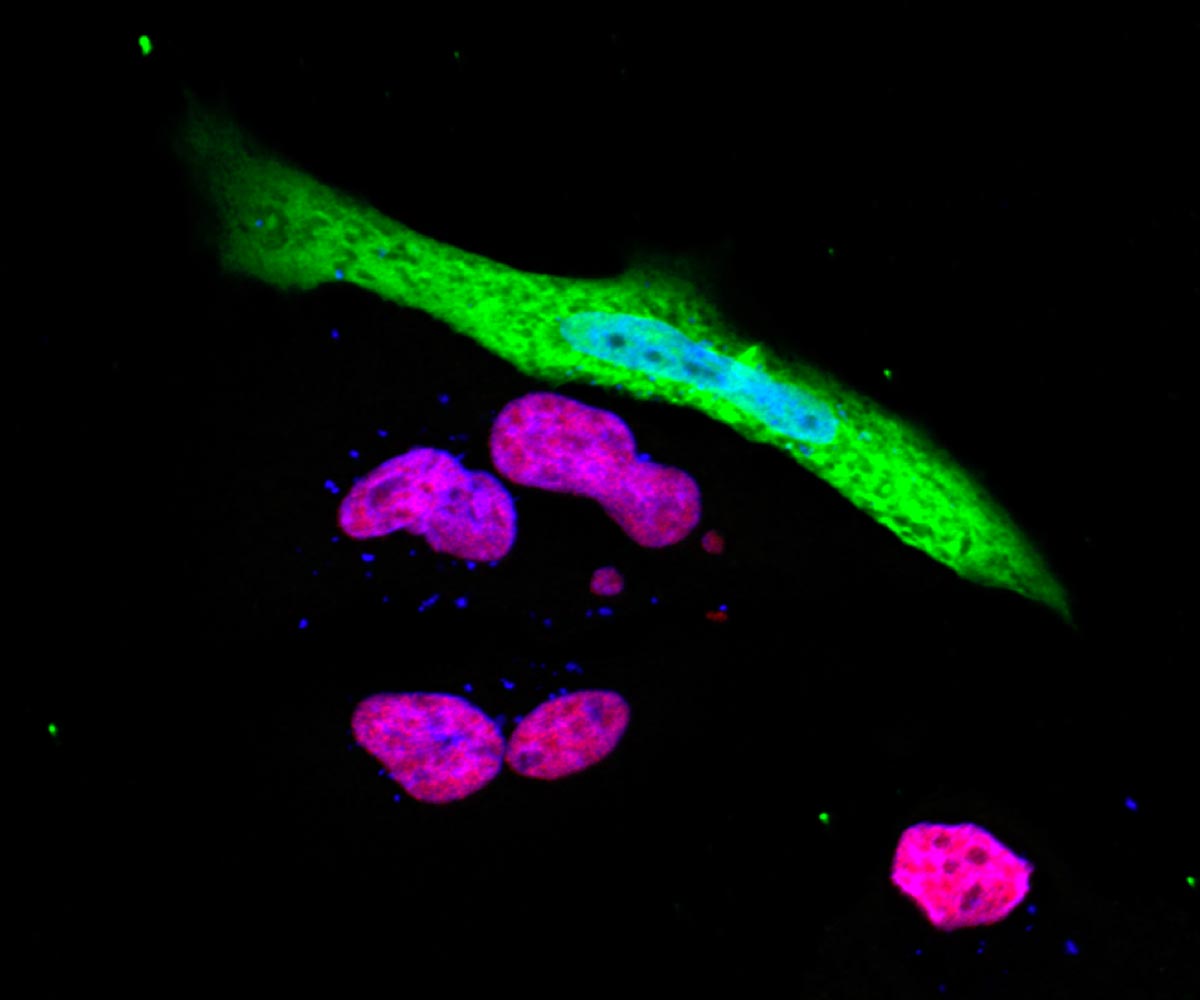Scientists Discover How the SARS-CoV-2 Virus Evades Our Immune System
0 View
Share this Video
- Publish Date:
- 8 December, 2021
- Category:
- Covid
- Video License
- Standard License
- Imported From:
- Youtube
Tags

The expression of the immune response gene NLRC5 (red-purple) is suppressed in SARS-CoV-2 (green) infected cells. Credit: Koichi Kobayashi
A discovery by researchers at Texas A&M College of Medicine could lead to new therapies to prevent the virus from spreading in the human body.
The immune system is a complex network of cells and proteins designed to fight infections and diseases, especially those like the coronavirus or SARS-CoV-2, which can cause a host of problems in the human body. But many people are still at risk of becoming infected with the coronavirus, allowing it to multiply in the body and be further passed on to other individuals.
The underlying mechanism of how SARS-CoV-2 escapes the immune system is poorly understood. However, researchers from Texas A&M University College of Medicine and Hokkaido University recently discovered an important mechanism that explains how SARS-CoV-2 can escape the immune system and multiply in the human body. Their findings were recently published in the journal Nature Communications.
SARS-CoV-2 escapes immune responses by cytotoxic T cells via reduced MHC-I expression caused by reducing both the amount and function of NLRC5. Credit: Koichi Kobayashi
“We found that the SARS-CoV-2 virus carries a suppressive gene that inhibits a human gene in the immune system that is essential for destroying infected cells,” says Dr. Koichi Kobayashi, adjunct professor in the College of Medicine and lead author of the paper.
Of course, the cells in a human’s immune system are able to control the virus infection by destroying infected cells so that the virus cannot replicate. The gene essential in carrying out this process, called NLRC5, regulates the major histocompatibility complex (MHC) class I genes, which are genes that create a pathway vital in providing antiviral immunity. Kobayashi and his colleagues discovered this in 2012.
“During infection, the amount and activity of the NLRC5 gene is increased to increase our ability to eradicate viruses,” Kobayashi said. “We found that the reason SARS-CoV-2 can replicate so easily is because the virus carries a suppressive gene called ORF6, which inhibits the function of NLRC5, and thus also inhibits the MHC class I pathway.”
dr. Koichi Kobayashi, adjunct professor in the College of Medicine and lead author of the paper. Credit: Texas A&M College of Medicine
Kobayashi, who is a joint professor at Hokkaido University in Japan, collaborated for this article with Paul de Figueiredo, an associate professor in the Department of Microbial Pathogenesis and Immunology at the College of Medicine.
The discovery by Kobayashi and his team sheds light on the mechanism of how SARS-CoV-2 can replicate in the human body and potentially lead to the development of new therapies to prevent the coronavirus from escaping the immune system and entering the immune system. body replicates.
While the introduction of COVID-19 vaccines, such as the Pfizer and Moderna vaccines, may reduce a person’s chance of contracting the virus, there is currently no permanent therapy that can completely prevent a person from developing SARS-CoV. 2 rises.
“We hope that this new discovery will allow us to develop a new drug that can block this gene so that our immune system can fight the coronavirus for good,” de Figueiredo said.
Reference: “SARS-CoV-2 inhibits the induction of the MHC class I pathway by targeting the STAT1-IRF1-NLRC5 axis” by Ji-Seung Yoo, Michihito Sasaki, Steven X. Cho, Yusuke Kasuga, Baohui Zhu, Ryota Ouda, Yasuko Orba, Paul de Figueiredo, Hirofumi Sawa, and Koichi S. Kobayashi, Nov. 15, 2021, Nature Communications.
DOI: 10.1038/s41467-021-26910-8










